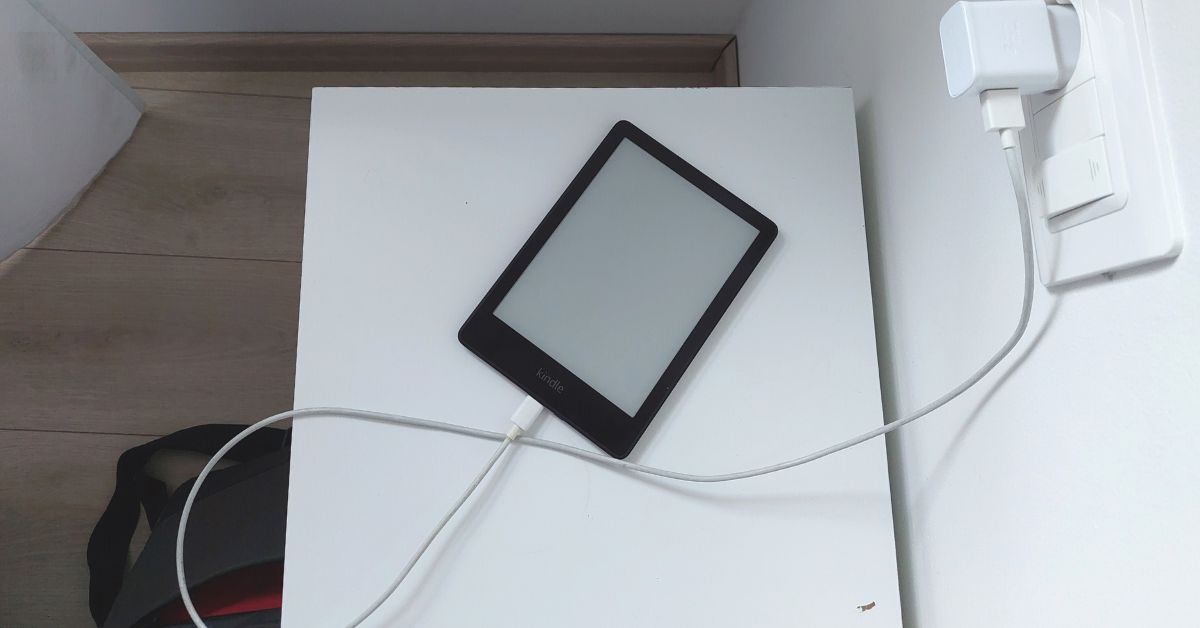Kindles are known for their long battery life and are great for travel purposes for this reason. But sometimes it may be the case that you don’t have enough time to spend hours waiting for the Kindle to charge. So how long does it take to charge a Kindle?
You can expect about two and half hours for a Kindle Paperwhite, two hours for a Kindle Oasis and about two and half hours for a Kindle Basic to get to a full charge.
Let’s look at the various charging times for the current lineup of Kindles, some tips for charging them and how to make sure they charge properly. Kindles do have great energy efficiency so if you charge them properly you’ll get many weeks of use.
How Long Does It Take for a Kindle to Charge?
When charging a Kindle, it will take a different amount of time to charge it depending on the type of charger and the amount of charge it has.
If the Kindle is in a very low charge state, the initial charging will be via a trickle charge which will be slower than the rest of it.
You can generally expect a 1400mAH battery in Kindles, so you can average out the charge time of 5 volts, often thought of in terms of mAh or Milliamp Hours. This mAh is used to measure the energy capacity of a battery.
To check the power rating of the charger you’re going to use, just look at the plug and check the number of watts written on the plug. Keep in mind that the amps that the Kindle can draw will also be a limiting factor.
For example, for the USB 2.0 specification, you’ll get a maximum charge rate of 5W on earlier Kindle devices (Kindle Paperwhite 10th Gen or earlier) as they can only draw 1 amp.
Keep in mind that some of the newer Kindles come with USB-C instead of microUSB. The big difference here is that you’ll get a much faster USB-C charge rate of 2 amps meaning 10W, so you should see a much quicker charge time.
| Kindle Model | Time |
|---|---|
| Kindle Paperwhite (5W USB) | 2.5 hours |
| Kindle Signature Paperwhite (5W USB) | 2.5 hours |
| Kindle Oasis (5W USB) | 2 hours |
| Kindle Basic (5W USB) | 2.5 hours |
How Long Does It Take to Charge Kindle Paperwhite?
In total you’ll likely need about two to two and a half hours to fully charge a Kindle Paperwhite.
Below 15%, you’ll generally get trickle charge rates, so you can expect that charging up to 5% will take about 20 minutes. It’s best if you don’t let the Kindle drain completely to zero anyway if you can help it, as this will help extend the battery’s life.
After you get over 15%, the charge rate will go up a lot so you can expect to get to 20% in about 30 to 40 minutes, and get to half charge of 50% somewhere around the one hour to hour and 20 minute mark.
You can expect to get to the 70% mark of charge at near the 2 hour mark, and get to the 90% charge level at around 2 hours 15 minutes. 100% full charge will be reached around 2 hours and 30 minutes after first plugged in if you started at 0%.
These times will be achieved on newer Kindles, as the older a Kindle is, and the more times it’s been charged and used, will significantly affect the battery’s lifespan, capacity and charging rates.
It’s not uncommon to find with some Paperwhites that you can’t get up to the full charge and it will be stuck on 95% to 98%.
This is nothing to worry about, and the old way of thinking with batteries that you should fully drain then fully charge them is not quite the point with lithium ion batteries.
| Charging Progress | Time |
|---|---|
| 5% | 20 minutes |
| 20% | 30 to 40 minutes |
| 50% | 1 hour 20 minutes |
| 70% | 2 hours |
| 90% | 2 hours 15 minutes |
| 100% | 2 hours 30 minutes |
How to Tell if Kindle Is Charging?
There is a light to tell you the status of the Kindle, with the light turning orange or amber. You can also see on the Kindle’s display itself, as it will show a lightning symbol over the battery.
The light will change to green and you’ll have a full battery icon once it’s done.
How to Eject Kindle From Computer While Charging?
Most Kindles organize their libraries via wireless, so you don’t have to worry about safely ejecting the Kindle. The newer versions of Kindle only work via wireless content management, so the only reason to plug those types of Kindles in is to charge it.
Sometimes you may get a message that you need to eject it if you want to read the Kindle while charging via USB when connected to the computer, and this menu can be found at the bottom right of the screen of your computer.
Left click on the USB icon, and select the Kindle and eject it.
How to Take Proper Care of Kindle Battery?
You’ll want to charge the Kindle when it’s getting low, and waiting for it to completely drain is not always possible (and may even be inconvenient while you’re traveling) and not the best method for lithium ion batteries.
Generally, you’ll want to keep it above 15% power and below 85% power to get the longest lifespan out of your battery.
Some more recent chargers will stop once the device is fully charged, and so you can leave the Kindle on charge the entire time, but generally it’s not a good idea for long term health of your Kindle to always leave it on charge.
You can improve the battery life by turning on Airplane mode on the Kindle by swiping down from the top menu while the Kindle is on. Airplane mode will turn off wireless functionality, which can drain the battery over time.
You can hit the power button on the Kindle to put the Kindle into sleep mode, reducing the drain on the battery.
Keep in mind that the Kindle uses very little battery when it is not turning the pages and so you’re not going to see a massive improvement in battery life just by putting it into sleep mode.
You can also hold the power button down for at least five seconds to bring up a prompt to turn off the screen to further save power, as in sleep mode the Kindle will still display a static screensaver.
If you have a Kindle that has an ad-supported lockscreen, turning off the screen like this may save a slight amount of battery life but again you’re not going to see a massive impact on longevity.
The other setting you change to take care of your Kindle battery is to adjust the light settings. Depending on your Kindle, you can set up a schedule to lower the lights or change the light levels (on the Kindle Oasis) or you can just manually move the light level down.
You can reduce the light level via Kindle itself. From the home screen, swipe down to open the Quick Actions menu or select the Settings icon. If you’re already in a book, you can just tap the top of the screen to access this.
You should see the scale to adjust, or hit the – button to drop it down a few levels. If you want to turn off the front light completely, long press the – button Kindle devices.
You can even go with Dark Mode from the same settings to reduce the light.
Can You Use a Phone Charger for Kindle?
You can charge Kindle devices using almost any microUSB or USB-C charger, depending on whether your Kindle supports the former or latter. The Kindle has a relatively small battery in it and doesn’t use a lot of power, it can charge quite well on a phone charger.
This is particularly the case when you realize that Kindles are not sold with specialist chargers (or any charger at all, for that matter).
Amazon also doesn’t give detailed instructions about what chargers can’t be used, so it is a way of realizing that it doesn’t particularly matter what wattage or type of charger you use. However, it’s best to use a proper charger as cheap chargers aren’t as consistent.
Generally you’ll want to use a slightly newer charger to ensure it is 5W, otherwise it will take longer to charge.
It’s best if you use a wall adaptor and USB cord rather than relying on the computer as a power source. A wall adapter will give you a mucher higher power output, causing your Kindle to be charged quicker.
This is because USB, especially older USB plugs, are set to older USB specifications which can’t handle high power output. If the USB plug is blue, that means its USB 3.0, meaning it will have a higher power output. USB 2.0 is white.
Some of the Apple chargers won’t work, because they use the Lightning connector, which is not compatible with the microUSB or USB-C format.


